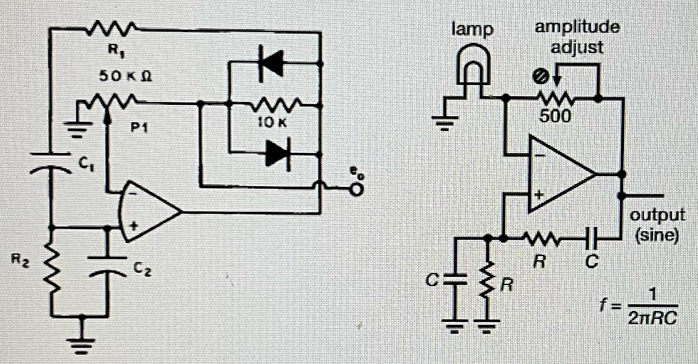Design your own oscillator based on the Wein-bridge configuration. (See Alexander section 10.9.2.) Use one of the two circuits below. Each has a non-linear element (lamp or diodes) to stabilize the circuit. The non-linear element is needed to ensure that the amplification will be exactly three (otherwise, the op-amp output increases to one rail or the other or decays to zero).
Design your own oscillator based on the Wein-bridge configuration. (See Alexander section 10.9.2.) Use one of the two circuits below. Each has a non-linear element (lamp or diodes) to stabilize the circuit. The non-linear element is needed to ensure that the amplification will be exactly three (otherwise, the op-amp output increases to one rail or the other or decays to zero).
Introductory Circuit Analysis (13th Edition)
13th Edition
ISBN:9780133923605
Author:Robert L. Boylestad
Publisher:Robert L. Boylestad
Chapter1: Introduction
Section: Chapter Questions
Problem 1P: Visit your local library (at school or home) and describe the extent to which it provides literature...
Related questions
Question
Answer number 5

Transcribed Image Text:Design your own oscillator based on the Wein-bridge configuration. (See Alexander section
10.9.2.) Use one of the two circuits below. Each has a non-linear element (lamp or diodes) to
stabilize the circuit. The non-linear element is needed to ensure that the amplification will be
exactly three (otherwise, the op-amp output increases to one rail or the other or decays to
zero).
C₁
R₁
50 k
P1
*
www
10 K
lamp
off®
R
amplitude
adjust
500
R C
3) Explain why each circuit has an adjustable potentiometer
4) Describe the Barkhausen criteria in your own words
5) Explain why the amplification must be three
f=
1) Discuss why you chose the resistor/capacitor values you selected.
2) Show hand calculation of the expected frequency
output
(sine)
Use the LM358 as your op-amp and only use capacitors and resistors that you have on hand.
You should have bought a lamp from first term or you just can use a couple of diodes 1N4004.
2лRC
Expert Solution
Step 1
Since user has asked about the question 5. Hence, we will provide the solution for the same.
According to the question, for the given circuit as shown below

We need to explain why the amplification must be 3.
Step by step
Solved in 3 steps with 2 images

Knowledge Booster
Learn more about
Need a deep-dive on the concept behind this application? Look no further. Learn more about this topic, electrical-engineering and related others by exploring similar questions and additional content below.Recommended textbooks for you

Introductory Circuit Analysis (13th Edition)
Electrical Engineering
ISBN:
9780133923605
Author:
Robert L. Boylestad
Publisher:
PEARSON

Delmar's Standard Textbook Of Electricity
Electrical Engineering
ISBN:
9781337900348
Author:
Stephen L. Herman
Publisher:
Cengage Learning

Programmable Logic Controllers
Electrical Engineering
ISBN:
9780073373843
Author:
Frank D. Petruzella
Publisher:
McGraw-Hill Education

Introductory Circuit Analysis (13th Edition)
Electrical Engineering
ISBN:
9780133923605
Author:
Robert L. Boylestad
Publisher:
PEARSON

Delmar's Standard Textbook Of Electricity
Electrical Engineering
ISBN:
9781337900348
Author:
Stephen L. Herman
Publisher:
Cengage Learning

Programmable Logic Controllers
Electrical Engineering
ISBN:
9780073373843
Author:
Frank D. Petruzella
Publisher:
McGraw-Hill Education

Fundamentals of Electric Circuits
Electrical Engineering
ISBN:
9780078028229
Author:
Charles K Alexander, Matthew Sadiku
Publisher:
McGraw-Hill Education

Electric Circuits. (11th Edition)
Electrical Engineering
ISBN:
9780134746968
Author:
James W. Nilsson, Susan Riedel
Publisher:
PEARSON

Engineering Electromagnetics
Electrical Engineering
ISBN:
9780078028151
Author:
Hayt, William H. (william Hart), Jr, BUCK, John A.
Publisher:
Mcgraw-hill Education,